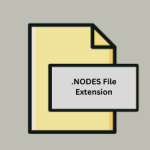.RTI File Extension

Real Tracker Instrument
| Developer | N/A |
| Popularity | |
| Category | Audio Files |
| Format | .RTI |
| Cross Platform | Update Soon |
What is an RTI file?
In the vast digital landscape of file extensions, each one serves a specific purpose and is associated with various software applications. One such intriguing file extension is .RTI, standing for Real Tracker Instrument.
The .RTI file extension is not as widely recognized as some others, but it has a unique history and purpose that make it worth exploring.
In this article, we will delve into the world of .RTI files, uncovering their origin, history, file structure, advantages, disadvantages, and how to open or convert them on different operating systems.
More Information.
Real Tracker Instrument (.RTI) files were created as a means to store instrument data within Real Tracker compositions.
In the context of music trackers, an instrument is a set of parameters and samples that define the sound produced by a particular track.
These instruments were essential for musicians using Real Tracker, as they allowed for the creation of unique sounds and melodies.
The primary purpose of .RTI files was to enable musicians to share their compositions along with the custom instruments they had created.
This feature made it easier for artists to collaborate and exchange music without losing the specific sounds they had meticulously crafted.
.RTI files essentially acted as containers for instrument data, ensuring the authenticity and accuracy of the music.
Origin Of This File.
The .RTI file extension traces its roots back to the world of music composition and audio production. It is primarily associated with Real Tracker, a music tracker software that gained popularity in the early 1990s.
Real Tracker was developed by Anders Persson and became a popular choice among musicians and composers for creating tracker music.
File Structure Technical Specification.
To understand the structure of .RTI files, one must delve into the technical specifications. .RTI files are binary files that contain various sections, each serving a specific purpose:
- Header: The header section typically contains metadata about the .RTI file, including the version of Real Tracker used, the number of instruments, and other relevant information.
- Instrument Data: This section stores data related to the instruments used in the composition. It includes information about sample files, playback settings, and other parameters that define the instrument’s sound.
- Sample Data: .RTI files also include sample data, which consists of the audio samples used by the instruments. These samples are typically in a raw audio format or a specific tracker-compatible format.
- Patterns: Patterns in .RTI files define the musical notes and events that make up the composition. These patterns are a crucial part of the tracker music creation process.
- Order List: The order list determines the sequence in which patterns are played in the composition, providing the overall structure of the song.
How to Convert the File?
Here’s a step-by-step guide on how to convert .RTI files to other formats using a Windows-based converter like OpenMPT (Open ModPlug Tracker):
Download and Install OpenMPT:
- Visit the official OpenMPT website at https://openmpt.org/ and download the latest version of OpenMPT for your Windows operating system (32-bit or 64-bit).
- Run the installer and follow the on-screen instructions to install OpenMPT on your computer.
Launch OpenMPT:
- After installation, launch OpenMPT from your Start menu or desktop shortcut.
Open the .RTI File:
- In OpenMPT, click on “File” in the menu bar and select “Open” or press Ctrl + O on your keyboard.
- Navigate to the location where your .RTI file is located and select it.
Select the Output Format:
- Once the .RTI file is loaded in OpenMPT, go to the “File” menu and choose “Save As.”
- In the “Save As” dialog, you can select the desired output format for conversion. Common options include .MIDI, .WAV, or other supported formats.
- Choose the output format that best suits your needs.
Configure Conversion Settings (if applicable):
- Depending on the selected output format, you may have additional configuration options. For example, when converting to .WAV, you can specify the sample rate, bit depth, and other audio settings. Adjust these settings as needed.
Specify the Output Location:
- After configuring the conversion settings, choose the destination folder where you want to save the converted file.
Initiate the Conversion:
- Click the “Save” or “Convert” button (depending on the software version) to initiate the conversion process.
- OpenMPT will process the .RTI file and create the converted file in the specified output format in your chosen destination folder.
Verify the Conversion:
- Once the conversion is complete, navigate to the output folder and check the converted file to ensure it meets your requirements.
Use the Converted File:
- You can now use the converted file in other music production software or share it with others as needed.
Advantages And Disadvantages.
Advantage:
- Preservation of Custom Instruments: .RTI files allow musicians to share compositions along with their custom instruments, preserving the unique sounds they’ve created.
- Compatibility: Real Tracker software is available on various platforms, making it accessible to a wide range of users.
- Lightweight: .RTI files are relatively small in size, making them easy to share and store.
Disadvantage:
- Limited Usage: The use of .RTI files is limited to Real Tracker software, which has become less common over the years.
- Incompatibility with Modern Software: Most modern music production software does not support .RTI files, making it challenging to integrate older compositions into new workflows.
How to Open RTI?
Open In Windows
- Using Real Tracker (Original Software): If you have access to a Windows system, you can open .RTI files using the original Real Tracker software. Download and install Real Tracker from a reliable source. Then, simply open the .RTI file within the program.
- Conversion to Other Formats: Convert the .RTI file to a more widely supported format like .MIDI or .WAV using a conversion tool like OpenMPT (as mentioned in the previous response). Once converted, you can use standard audio software to open and edit the converted file.
Open In Linux
Wine and Real Tracker:
- Install Wine, a compatibility layer for running Windows applications on Linux.
- Download the Windows version of Real Tracker and run it using Wine. Then, open the .RTI file within Real Tracker.
Conversion to Other Formats:
- Use OpenMPT or a similar converter on Linux to convert the .RTI file to a more common format like .MIDI or .WAV. After conversion, you can use various Linux audio software to work with the converted file.
Open In MAC
Wine and Real Tracker:
- Similar to Linux, you can install Wine on your macOS and run the Windows version of Real Tracker. Open the .RTI file within Real Tracker.
Conversion to Other Formats:
- Convert the .RTI file to a compatible format (e.g., .MIDI or .WAV) using a Windows-based converter run through Wine. After conversion, you can use macOS audio software to work with the converted file.
Open In Android
Use a Mobile Tracker App:
- Android devices do not natively support .RTI files. However, there are tracker-style music composition apps available on the Google Play Store. These apps may support .RTI files or offer similar functionality. Look for apps like SunVox or MilkyTracker.
Conversion on a PC:
- If you have access to a PC, convert the .RTI file to a more mobile-friendly format like .MIDI or .WAV using a converter tool. Then, transfer the converted file to your Android device for playback or editing.
Open In IOS
Use a Mobile Tracker App (if available):
- Search the App Store for iOS apps that offer tracker-style music composition capabilities. Some apps may support .RTI files or provide similar functionality.
Conversion on a PC or Mac:
- Convert the .RTI file to a compatible format on a Windows PC or Mac, and then transfer the converted file to your iOS device for use with music apps.
Open in Others
Emulators and Compatibility Layers:
- For other platforms or operating systems, consider using emulators or compatibility layers to run Real Tracker or Windows-based converters. This approach is platform-dependent and may require some technical expertise.
Cross-Platform Music Software:
- Explore cross-platform music production software that may offer compatibility with .RTI files or allow you to import them for further editing and conversion.













